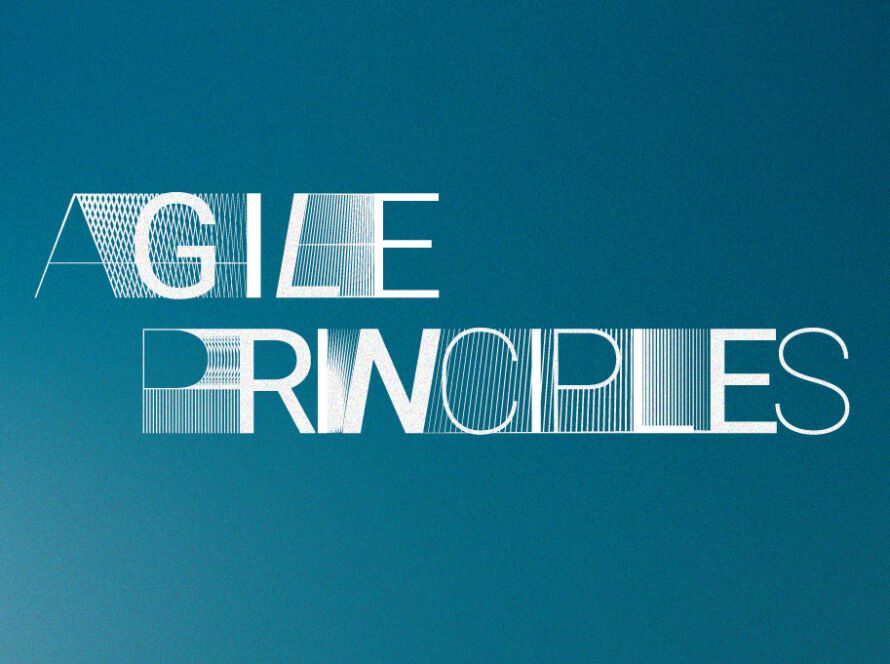The little agile ABC
Today, hardly any company can ignore the topic of “agility”. And that’s for good reason: The agile Transformation and an agile way of working creates clear and profitable competitive advantages. The company’s increased flexibility, speed and transparency improve not only customer satisfaction and time-to-market, but also employee satisfaction. Despite the high level of attention given to agile working, there is a lack of clear understanding of what agility means. Implementing the mindset of focus on personal responsibility, transparency, appreciation, and communication is only a small part of the journey into agility.
At this point, clarity is required. Which terms are particularly important and what they mean will be explained in the following blog post “Agile ABC”.
What is agility?
Agility is not a new topic; the term and the concept behind it have existed in various forms for many years. However, digitalization has given the term greater significance. Agility is no longer limited to individual organizational areas such as software development but is now applied to an entire company. Google, Spotify, Microsoft and YouTube have already been working successfully in an agile manner for many years.
The term “agile” means nimble, flexible, and quick. In business, agility refers to a company’s ability to adapt to new market conditions in the shortest possible time. Agility also makes it possible to act flexibly and in a customer-oriented manner through repetitive work cycles (iterations). The focus of collaboration is primarily on openness, trust, communication, and self-organization. Iterative processes based on regular consultation within a team lead to working more collaboratively and efficiently.
However, agility is above all a way of acting defined by values and guided by principles. In order for agility to be not only applied but also lived in the company, agile values and principles as well as a corporate culture must be implemented in the organization.
This is why agility is important
Our world continues to evolve and is characterized above all by its complexity and fast pace. Megatrends such as globalization and digitization are causing constant cross-industry changes and increase the dynamics of the markets. This development demands a high degree of flexibility from companies as well as the continuous adaptation and optimization of their strategy. At the same time, it is necessary to overcome the hurdles resulting from those dynamics.
One way for companies to overcome those challenges is to adopt an agile mindset and company culture. This allows motivation, personal responsibility and independent working to be supported and improved.
Why is the term so fuzzy?
Many companies equate agile working with a single method, such as Scrum or Kanban, and limit themselves exclusively to that. However, agile working means combining different forms of flexible collaboration and working together across disciplines. To make this possible, a fundamental mindset must additionally be formed.
In traditional companies, the concept of agility definitely meets with rejection. Especially in an increasingly complex and dynamic environment, organizations try to meet the demands of the environment through processes, rules and specifications. Such a bureaucratic environment results in decisions being delayed and valuable employee time being blocked. Rigid structures like these should be avoided.
In order to clear up ambiguities and prejudices, the most important terms that frequently occur in connection with an agile way of working are described below.
The agile ABC
Agile Coach
An agile coach acts as a consultant and supports individual teams or entire divisions in changing their processes as well as the mindset in order to improve their adaptiveness and self-learning capabilities. Compared to a traditional business consultant, the agile coach rather supports the team in solving future problems on their own.
(Agile) Leadership
The concept of leadership redefines the modern manager. Instead of controlling, leaders have to motivate and convince. Among other things leader responsibilities include removing impediments and empowering teams and employees. Leadership does not necessarily have to be assigned to a specific role but is potentially assumed by every employee. In this way, employees are given more responsibility and at the same time more trust.
Agile Manifest
The agile manifesto was formulated in 2001 by 17 experienced software developers and serves as a framework for action in which the agile principles and values are defined. For a practical insight into the agile manifesto, feel free to check out our blog post “The agile principles in practice“.
Agile Mindset
The agile mindset is a way of thinking and working throughout the company that defines the attitude of the entire team. In this way, the mindset forms the basis for agile working. Without the right mindset, agile transformation can neither be accomplished nor completed. If you want to learn more about the agile mindset, feel free to check out our blog post “Agile Mindset“.
Business Agility
Business agility describes the ability of the entire company not to operate in rigid structures, but to adapt quickly to changing conditions through proactive and iterative behavior. In an open error culture, the company’s own processes and projects should be constantly questioned and realigned.
Design Thinking
This highly iterative and creative process is used to develop solutions and ideas for complex problems and issues. The focus is primarily on the user of a product and their needs. Feel free to check out our blog post “What is Design Thinking” to learn more about the application as well as the benefits of the process.
Framework
The term framework can be understood as an umbrella term and in the context of agility it refers to a method or approach for scaling agile. Agile frameworks change the way teams collaborate and how they approach individual projects. Agile frameworks include Scrum, Kanban, SAFe and many more.
Holacracy
Holacracy describes a concept for agile organizing in which all team members are involved in decision-making. The idea behind this is that employees recognize and understand the meaning and connections of their work. Holacracy thus ensures good cohesion within a company and makes its purpose visible.
Incremental
A project is incremental when the overall workload gets divided into smaller work packages that can be completed throughout the process in order to continuously deliver small chunks of value.
Iterative
An iterative approach describes a work process in which the same or similar actions are repeated several times in order to approach a solution or a specific goal and improve in successive iterations.
Lean (Management)
Lean is an approach that reduces waste of any kind. The entirety of the methods and procedures used serve the efficient and optimized design of all processes in a company along the entire value chain. The focus is on customer orientation and cost reduction. Through lean management, for example, inventories, delivery times or error rates can be continuously optimized in line with the principles of a lean organization.
Objectives & Key Results
The OKR management method is used to set objectives. Objectives define the goals within an organization. They determine what is to be achieved in a certain time. Key Results can be used to measure the progress towards the previously set Objectives. The OKR method helps teams to pursue their objectives in a motivated and focused manner and to check the achievement of objectives at any time using measurable criteria.
Pull Principle
In contrast to the push principle, in which one person distributes the tasks to be completed, with the pull principle each employee decides independently which task he or she will take on next. In this way, no shortages arise, and the work can flow evenly.
SAFe
The Scaled Agile Framework (SAFe) provides a knowledge base of proven principles and practices to support enterprise agility and aims to logically link all levels and teams in an organization. This ensures a smooth workflow.
Scrum und Kanban
The two agile frameworks Scrum and Kanban are used to ensure efficient project progress. They favor a fast and flexible reaction to changing market or customer conditions. A feature of both methods is the visualization of the individual work steps. In our blog entry “Scrum vs. Kanban” you can learn more about the two methods and when which one should be used.
Corporate culture
A corporate culture forms the basic set of shared values, norms and attitudes and shapes the actions as well as the behavior of an entire organization. The successful integration of such a culture has a major impact on the motivation of employees to work and, in a best-case scenario, creates a positive and beneficial working environment. It also has an indirect effect on the economic success of a company and should therefore not be disregarded by managers.
Vision und Mission
Both the vision and the mission represent an agile guiding principle and can be derived from the corporate goals. Both are formulated to provide stakeholders with an overview of the company. While the mission describes the purpose of the company, the vision represents a future reality.
Conclusion on the agile ABC
Agility, with all its values, principles, and frameworks, is drastically changing the way we work today. It manages to generate transparency as well as self-responsibility and enables flexible adaptation to an ever-changing environment. At the beginning of every major change, the flow of new information seems to get out of hand and obscure the view of the essentials. But once clarity has been established, the journey into the no longer so woolly topic of agility can begin.
Contact
Are you interested in learning more about agile transformation? Feel free to contact us. We are happy to support you and look forward to hearing from you!





